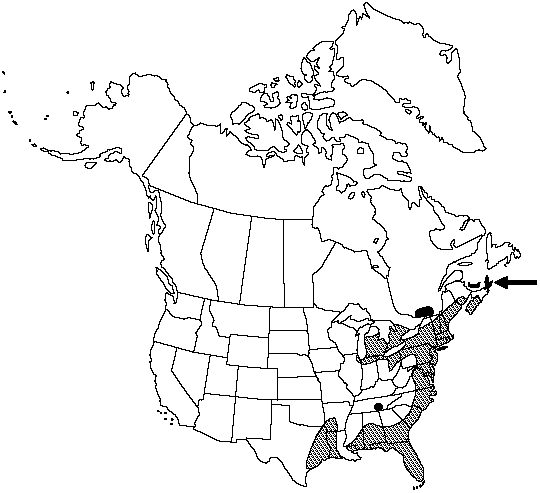Difference between revisions of "Woodwardia virginica"
5: 412. 1793.
FNA>Volume Importer |
FNA>Volume Importer |
||
| Line 22: | Line 22: | ||
}}<!-- | }}<!-- | ||
| − | --><span class="statement" id="st- | + | --><span class="statement" id="st-undefined" data-properties=""><b>Stems </b>long-creeping, ropelike; scales dark brown, few, triangular. <b>Leaves</b> monomorphic, deciduous, numerous, well separated, 50-100 cm. <b>Petiole</b> dark purple to black proximally, straw-colored distally, base lustrous and swollen, glabrate. <b>Blade</b> greenish, lanceolate, 28-60 cm, bearing mixture of glands and scales upon emergence with glands persisting. <b>Pinnae</b> articulate to rachis, arranged in 12-23 evenly distributed pairs, linear to narrowly lanceolate, deeply pinnatifid; middle pinnae 6-16 × 1-3.5 cm. <b>Veins</b> anastomosing to form a single row of areoles, then free to margin. <b>Sori</b> elongate, linear, superficial, often appearing confluent upon dehiscence of sporangia. <b>Indusia</b> ± membranous, lacking thickened cells, freely spreading, often hidden by dehisced sporangia. <b>2n</b> = 70.</span><!-- |
-->{{Treatment/Body | -->{{Treatment/Body | ||
| Line 51: | Line 51: | ||
|publication year=1793 | |publication year=1793 | ||
|special status= | |special status= | ||
| − | |source xml=https://jpend@bitbucket.org/aafc-mbb/fna- | + | |source xml=https://jpend@bitbucket.org/aafc-mbb/fna-data-curation.git/src/9216fc802291cd3df363fd52122300479582ede7/coarse_grained_fna_xml/V2/V2_683.xml |
|genus=Woodwardia | |genus=Woodwardia | ||
|species=Woodwardia virginica | |species=Woodwardia virginica | ||
| − | |||
| − | |||
| − | |||
| − | |||
| − | |||
| − | |||
| − | |||
| − | |||
| − | |||
| − | |||
| − | |||
| − | |||
| − | |||
| − | |||
| − | |||
| − | |||
| − | |||
| − | |||
| − | |||
| − | |||
| − | |||
| − | |||
| − | |||
| − | |||
| − | |||
| − | |||
| − | |||
| − | |||
| − | |||
| − | |||
| − | |||
| − | |||
| − | |||
| − | |||
| − | |||
| − | |||
}}<!-- | }}<!-- | ||
-->[[Category:Treatment]][[Category:Woodwardia]] | -->[[Category:Treatment]][[Category:Woodwardia]] | ||
Revision as of 13:26, 27 July 2019
Stems long-creeping, ropelike; scales dark brown, few, triangular. Leaves monomorphic, deciduous, numerous, well separated, 50-100 cm. Petiole dark purple to black proximally, straw-colored distally, base lustrous and swollen, glabrate. Blade greenish, lanceolate, 28-60 cm, bearing mixture of glands and scales upon emergence with glands persisting. Pinnae articulate to rachis, arranged in 12-23 evenly distributed pairs, linear to narrowly lanceolate, deeply pinnatifid; middle pinnae 6-16 × 1-3.5 cm. Veins anastomosing to form a single row of areoles, then free to margin. Sori elongate, linear, superficial, often appearing confluent upon dehiscence of sporangia. Indusia ± membranous, lacking thickened cells, freely spreading, often hidden by dehisced sporangia. 2n = 70.
Habitat: Swamps, marshes, bogs, and roadside ditches over noncalcareous substrates
Elevation: 0-300 m
Distribution

N.B., N.S., Ont., P.E.I., Que., Ala., Ark., Conn., Del., Fla., Ga., Ill., Ind., La., Maine, Md., Mass., Mich., Miss., N.H., N.J., N.Y., N.C., Ohio, Pa., R.I., S.C., Tenn., Tex., Vt., Va., W.Va., Bermuda.
Discussion
Woodwardia virginica is primarily confined to the coastal plain of eastern North America. It is not likely to be confused with any other species of the genus, but it is sometimes mistaken for Thelypteris palustris (Linnaeus) Schott, T. interrupta (Willdenow) K. Iwatsuki, or Osmunda cinnamomea. It may be distinguished from the first by having netted venation, from the second by having linear sori, and from Osmunda by having blackish petiole bases.
Selected References
None.